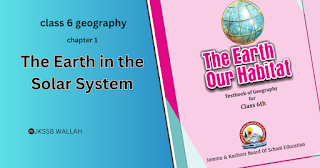JKBOSE,NCERT geography class 6 The earth our habitat
class 6 geography chapter 1: The Earth in the Solar System –
1. Answer the Following Questions Briefly.
A).How does a planet differ from a star?
Ans: Planets don’t have their own heat and light, they are lit by stars. Stars, on the other hand, are made of gas and have their own heat and light.
B. What is meant by the ‘Solar System’?
Ans:The solar system is like a big family led by the Sun, with the Sun itself, eight planets, their satellites, and additional celestial bodies such as asteroids and meteoroids all being part of this cosmic family.
C. Name all the planets according to their distance from the Sun.
Ans: The planets in our solar system according to distance from sun are:
Mercury,
Venus,
Earth,
Mars,
Jupiter,
Saturn,
Uranus,
Neptune.
D. Why is the Earth called a unique planet?
Ans: Earth is unique among planets because it supports life. It has favorable conditions such as air, water, and life-sustaining gases. Additionally, it maintains a moderate temperature, neither too hot nor too cold.
E. Why do we see only one side of the Moon always?
Ans: We can only see one side of the moon at all times because it takes approximately 27 days to complete one rotation around the Earth. As a result, only one side of the moon is visible to us.
E. Why do we see only one side of the Moon always?
Ans: The Universe is made up of countless galaxies. A galaxy is a system that contains billions of stars, planets, clouds of dust, and other celestial objects.
2. Tick the Correct Answer.
A. The planet that is known as the “Earth’s Twin” is:
1. Jupiter
2. Saturn
3. Venus
Ans: (3) Venus
B. Which is the third nearest planet to the Sun?
1. Venus
2. Earth
3. Mercury
Ans: (2) Earth
C.. All the planets move around the Sun in
1. Circular path
2. Rectangular path
3. Elongated path
Ans: (3) Elongated path
D. The Pole Star indicates the direction to the
1. South
2. North
3. East
Ans: (2)North
E. steroids are found between the Orbits of
1. Saturn and Jupiter
2. Mars and Jupiter
3. The Earth and Mars
Ans: (2) Mars and Jupiter
3. Fill in the Blanks
A. A group of _____ forming various patterns is called a _____.
Ans: stars, constellations
B. A huge system of stars is called ____.
Ans: galaxy
C. _____ is the closest celestial body to our earth.
Ans: Moon
D. ____ is the third nearest planet to the sun.
Ans: Earth
E. Planets do not have their own _____ and _____ .
Ans: heat, light

